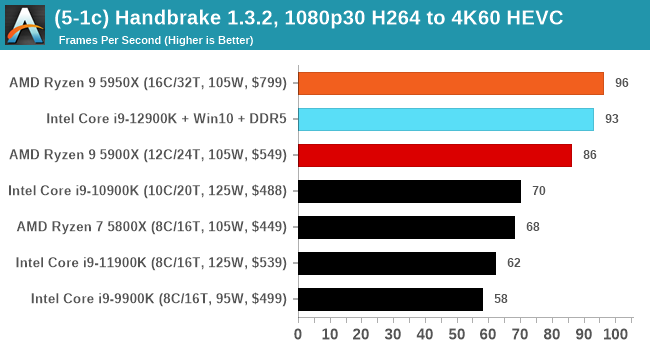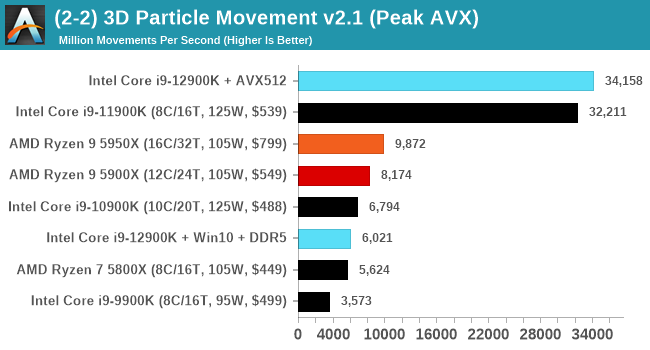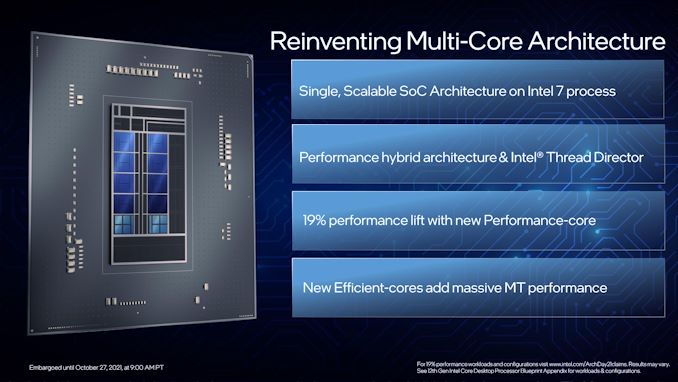The Intel 12th Gen Core i9-12900K Review: Hybrid Performance Brings Hybrid Complexity
by Dr. Ian Cutress & Andrei Frumusanu on November 4, 2021 9:00 AM ESTConclusion: Variables Maketh the CPU
Suffice to say, Intel’s new 12th Generation Core family has added more variables to the mix than a traditional processor launch. The combination of different types of core, coming at a time where a new operating system has just been launched, but also at the inflection point of a new type of memory. Let’s break down some of the differences we’ve observed in our testing.
When we compare Windows 10 to Windows 11, purely on throughput benchmarks, we don’t find much difference. There are a few spots where Windows 11 has a slight advantage in multi-threaded workloads, but this comes down to how new threads are spawned between the performance cores and the efficiency cores. Intel stated that the performance between the two, at least for CPU workloads, should be within a few percentage points, stating that Windows 11 should have lower run-to-run variance. We can corroborate this in our testing. Windows 10 also had some scheduling issues with low priority threads, which we expect to be ironed out with updates.
Comparing the new DDR5 to the old DDR4 is a different story, as the new memory standard offers a substantial uplift when it comes to memory bandwidth. As we saw recently with the M1 Max review, sometimes memory bandwidth can be a limiting factor. In our testing, DDR5 had a minor lead in single threaded tests but in a lot of multithreaded tests, the lead was significant. For real world, we had examples of +14% in Agisoft, +10% in NAMD, +8% in V-Ray, +10% in Handbrake, and +20% in WinRAR. In SPEC2017, we saw a couple of single threaded workloads get +15% improvements over DDR5, but in multi-threaded this was up to +40% on average, or more than 40% in specific tests. This also comes down to the doubled memory channels (4x32-bit vs 2x64-bit) which can be better utilized on top of the bandwidth increases.
Now comparing the P-core to the E-core, and it’s a story of how the E-core individually can perform on par with a Skylake core. Having eight extra Skylake-class cores is nothing to be sniffed at. In a lot of tests the E-core is half the performance of the P-core, but the P-core is itself is now the market leader in performance. The Golden Cove core inside Alder Lake has reclaimed the single-threaded performance crown with an uplift in SPEC of 18-20%, which is in line with Intel’s 19% claim. This puts it ahead of Apple’s M1 Max or 6% (int) and 16% (fp) ahead of AMD’s Zen 3 core.
The Core i9-12900K
Combining fast P-cores, Skylake-class E-cores, and DDR5 into one package means that Intel has certainly jumped from behind the competition to in front of it, or at least in the mix. When you have your operating system set up just right, and no issues with schedulers, it outperforms AMD’s offering when single core performance matters, and in multi-threaded workloads, it does tend to sit somewhere between a 5900X and a 5950X.

It’s important to note that in some tests, the Core i9-12900K does win outright. It’s at this point we should consider how much is core related vs standards related: DDR5 has produced somewhat of an uplift, and the competition is expected to claw some of that back when they introduce it, but those products are expected more towards the latter half of 2022. For users with those specific workloads today, and willing to pay the DDR5 early adopter tax, Alder Lake can provide performance uplifts right now.

Power is an interesting topic, and although our peak power numbers when all cores were loaded were above the 241W Turbo power on the box, in real world workloads it didn’t tend to go that high. The P-cores alone on the chip matched the power consumption of Intel’s 11th Generation in AVX2 workloads, but adding in the E-cores does put it over the previous generation. I’m not entirely sure what that says about Intel’s 7 manufacturing process compared to the 10SF used before. A lot of the performance gains here appear to come from IPC and DDR5, and that doesn’t seem to have come with performance per watt gains on the P-cores. It means that Intel is still losing on power efficiency at load compared to the competition.

I have to say a side word about AVX-512 support, because we found it. If you’re prepared to disable the E-cores, and use specific motherboards, it works. After Intel spent time saying it was fused off, we dug into the story and found it still works for those that need it. It’s going to be interesting to hear how this feature will be discussed by Intel in future.
Overall though, it’s no denying that Intel is now in the thick of it, or if I were to argue, the market leader. The nuances of the hybrid architecture are still nascent, so it will take time to discover where benefits will come, especially when we get to the laptop variants of Alder Lake. At a retail price of around $650, the Core i9-12900K ends up being competitive between the two Ryzen 9 processors, each with their good points. The only serious downside for Intel though is cost of switching to DDR5, and users learning Windows 11. That’s not necessarily on Intel, but it’s a few more hoops than we regularly jump through.











474 Comments
View All Comments
Wrs - Saturday, November 6, 2021 - link
@Netmsm I'll leave that to the market as I don't foresee using any of the 3 that soon lol. It would stand to reason that if one product is both cheaper and better, it would keep gaining share at the expense of the other. If that doesn't happen I would question the premise of cheaper + better. And seeing as it's a major market for Intel, I have little doubt they'll adjust prices if they do find themselves selling an inferior product.Netmsm - Sunday, November 7, 2021 - link
That's right. We always check performance per watt and per dollar. A product should be reasonable with respect to its price and power consumption, this is a must.12900k can consume up to 241 which is very closer to Threadripper not Ryzen 5900's TDP and yet competing with chips having 125 TDP! What a parody this is!
I can't disregard and throw away efficiency factor, that's all.
Spunjji - Friday, November 5, 2021 - link
Seeing this has made me very interested to see the value proposition Alder Lake will be offering in gaming notebooks. I was vaguely planning to switch up to a Zen 3+ offering for my next system, but this might be enough to make me reconsider.EnglishMike - Thursday, November 4, 2021 - link
<blockquote>re: Enterprise: Considering power consumption, it's like a Pyrrhic victory for Intel.</blockquote>Why? This is not an enterprise solution -- that's the upcoming Sapphire Rapids Xeon processors, a completely different CPU platform.
Sure, if all you're doing is pegging desktop CPUs at 100% for video processing or a similar workload, then Alder Lake isn't for you, but the gaming benchmarks clearly show that when it comes to more typical desktop workloads, the i9 12900k is inline with the top of the line AMD processors in terms of power consumption.
Netmsm - Thursday, November 4, 2021 - link
and who in his right mind would believe that upcoming Xeon processors can bring revolutionary breakthrough in power consumption?!EnglishMike - Friday, November 5, 2021 - link
And that, my friend, is a great example of moving the goalposts.We'll have to see what Intel offers re: Xeon's but one thing is for sure, they're going to offer a completely different power profile to their flagship desktop CPUs, because that's the nature of the datacenter business.
Netmsm - Saturday, November 6, 2021 - link
Of course the nature of enterprise won't accept this power consumption. In PC world customers may not care how ineffective a processor is. Intel will reduce the power consumption but the matter is how its processor will accomplish the job! We see an unacceptable performance to watt in Intel's new architecture that needs something like a miracle for Xeon's to become competitive with Epyc's.Wrs - Saturday, November 6, 2021 - link
No miracle is needed... just go down the frequency-voltage curve. Existing Ice Lake Xeons already do that. What's new about Sapphire Rapids is not so much the process tech (it's still 10nm) but the much larger silicon area enabled per package due to the EMIB packaging. That's their plan to be competitive with Epyc and its multichip modules.Netmsm - Sunday, November 7, 2021 - link
And what will happen to performance as frequency-voltage curve goes down?Just look at facts! With about 100w more power consumption Intel's new architecture gets itself in front of Zen 3 by a slight margin in some cases that lucidly tells us it can never reduce power consumption and yet beat Epyc in performance.
Wrs - Sunday, November 7, 2021 - link
@Netmsm I'm looking at facts. The process nodes are very similar. One side has both a bigger/wider core (Golden Cove) and a really small core (Gracemont). The other side just has the intermediate size core (Zen 3). As a result, on some benchmarks one side wins by a fair bit, and on other benchmarks, the other side takes the cake. Many benches are a tossup.In this case the side that theoretically wins on efficiency at iso-throughput (MC performance) is the side that devotes more total silicon to the cores & cache. When comparing a 12900k to a 5950x, the latter has slightly more area across the CCDs, about 140 mm2 versus around 120 mm2. The side that's more efficient at iso-latency (ST/lightly threaded) is the one that devotes more silicon to their largest/preferred cores, which obviously here is ADL. In practice companies don't release their designs at iso-performance, and for throughput benchmarks one may encounter memory and other platform bottlenecks. But Intel seems to have aggressively clocked Golden Cove such that it's impossible for AMD to reach iso-latency with Zen 3 no matter the power input (i.e., you'd have to downclock the ADL). That has significant end-user implications as not everything can be split into more threads.
The Epyc Rome SKUs are already downclocked relative to Vermeer, like most server/workstation CPUs. Epyc Rome tops out at 64 Zen3 cores across 8 chiplets. Sapphire Rapids, which isn't out yet, has engineering samples topping out at 80 Golden Cove cores across 4 ~400mm2 chiplets. Given what we know about relative core sizes, which side is devoting more silicon to cores? There's your answer to performance at iso-efficiency. That's not to say it's fair to compare a product a year out vs. one you can obtain now, but also I don't see a Zen4 or N5 AMD server CPU within the next year.